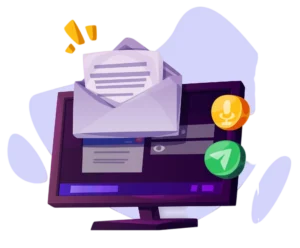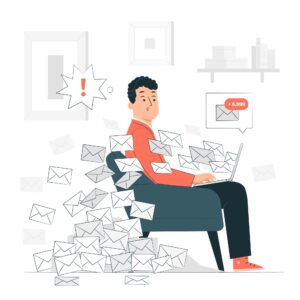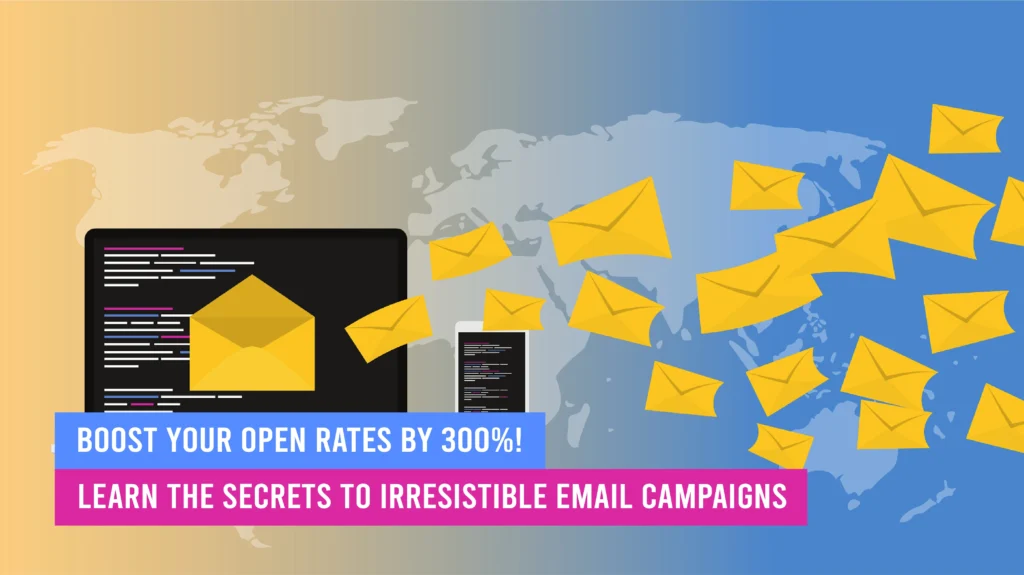In the vast world of digital marketing, email remains one of the most powerful tools in your arsenal. Whether you’re promoting a new product, sharing a blog post, or just keeping your audience engaged, getting your emails opened is the first crucial step. But let’s be honest, with inboxes flooded every day, how do you make sure your email stands out? How do you get that 300% boost in open rates that every marketer dreams of?
I’ve been in your shoes—fresh out of school, eager to make a mark in digital marketing. I quickly learned that it’s not just about sending an email; it’s about sending the right email. So, let’s dive into some secrets that helped me, and can help you too, craft irresistible email campaigns that your audience can’t wait to open.
Table of Contents
ToggleUnderstanding the Basics of Open Rates in Email Marketing
Before we jump into the nitty-gritty, let’s get clear on what open rates in email marketing actually are. Simply put, your open rate is the percentage of recipients who open your email. It’s a key metric that tells you how effective your subject lines are, how interested your audience is, and whether your email is hitting their inbox or the dreaded spam folder.
Industry Benchmarks: Where Do You Stand?
When I first started, I was obsessed with numbers. I’d send an email, then refresh my analytics dashboard every few minutes. Sound familiar? But to make sense of those numbers, it’s important to know what’s considered a “good” open rate. While it varies by industry, a typical open rate hovers around 20-30%. If you’re below that, don’t panic—there’s plenty of room for improvement, and that’s where the fun begins!
Crafting Irresistible Subject Lines
Ah, the subject line—the make-or-break element of your email campaign.
If your subject line doesn’t stand out, your email will be ignored, leading to a poor conversion rate in email marketing.
The Power of the Subject Line
Think about the last time you scrolled through your inbox. Which emails did you click on? Chances are, it was the ones with subject lines that caught your eye. Your subject line is the first thing your audience sees, so it needs to be strong enough to spark curiosity or offer value.
Tips for Writing Compelling Subject Lines
Here are a few tips that have worked wonders for me:
Keep It Short and Sweet: Aim for around 6-10 words. Long subject lines can get cut off, especially on mobile.
Use Personalization: Including the recipient’s name or a detail like their city can make your email feel more relevant and personal. I once applied this strategy in a local event campaign, and the open rates in email marketing jumped by 20%!
Create Curiosity: Phrases like “You won’t believe this…” or “Guess what we’ve got for you!” make people want to click just to find out what’s inside.
Incorporate Emojis (Judiciously): Emojis can add personality to your subject line, but use them sparingly. They’re great for catching the eye but can come off as unprofessional if overused.
Timing Is Everything
- Let’s talk timing. You could have the best email in the world, but if you send it at the wrong time, it might never get the attention it deserves.
Optimal Send Times
When I first started experimenting with send times, I learned pretty quickly that timing can significantly impact open rates. For most audiences, Tuesday, Wednesday, and Thursday mornings tend to work best, especially around 10 AM. People are typically clearing out their inboxes and are more likely to engage with new emails.
Day of the Week Considerations
Weekends? Not so much. People are often less likely to check work emails over the weekend. Mondays can be tricky too, as inboxes are usually overflowing from the weekend, and your email might get buried.
Testing and Adjusting
Of course, every audience is different, so I recommend A/B testing different days and times to see what works best for your specific audience. You might find that your audience prefers Friday afternoons or early mornings—experiment and find your sweet spot!
Segmenting Your Audience
Now, let’s get into one of the most effective strategies for boosting open rates: segmentation. Not all your subscribers are the same, so why treat them that way?
Why Segmentation Matters
Segmentation involves dividing your email list into smaller groups based on certain criteria, like demographics, behavior, or interests. This allows you to send more targeted and relevant emails to each group.
Effective Segmentation Strategies
Here’s how you can start segmenting:
Demographics: Segment by age, gender, location, etc. If you’re running a promotion in a specific city, only target subscribers in that area.
Behavioral Segmentation: Track how subscribers interact with your previous emails. Are they clicking on product links? Then they’re probably interested in shopping, so send them offers.
Interest-Based Segmentation: Use surveys or past interactions to understand what topics your subscribers are interested in. If someone consistently clicks on blog posts about SEO, they’ll appreciate receiving more content on that topic.
I remember running a campaign where we segmented our list based on purchase history. We sent a special offer to high-value customers, and the open rate for that segment was nearly double that of our general list!
Crafting High-Quality Email Content
So, your subject line worked, and your timing was spot on. Great! But what happens after they open the email? If your content doesn’t deliver, you’ve lost them for good.
The Role of Content in Open Rates
Quality content doesn’t just keep your readers engaged; it also influences whether they’ll open your future emails. If your emails consistently provide value, readers will look forward to them.
Relevance: Make sure the content matches the segment you’re targeting. A personalized email with irrelevant content can backfire.
Value: Always ask yourself, “What’s in it for them?” Whether it’s a discount, a useful tip, or exclusive content, make sure your email offers something of value.
Engagement: Keep the content engaging by using a mix of text, images, and even videos. Don’t forget to include a clear call-to-action (CTA) to guide your readers on what to do next.
Leveraging Personalization and Automation
As you grow in your digital marketing career, you’ll find that automation tools can be your best friend, helping you send personalized content at scale.
Personalization Beyond the Name
Personalization is more than just inserting the recipient’s name in the email. It’s about delivering content that feels tailor-made for them. For example, if you know someone has been browsing your website for sneakers, sending them an email featuring your latest sneaker collection is much more likely to get opened.
Using Automation for Consistency
Automation tools like Mailchimp or HubSpot allow you to set up workflows that send emails based on specific triggers. For example, you can automatically send a welcome email when someone subscribes or a follow-up email when someone abandons their cart. This ensures consistent communication without the manual effort.
Testing and Analysing Your Campaigns
If you’re serious about boosting open rates of your email, testing and analysing your campaigns is non-negotiable.
A/B Testing Subject Lines and Content
A/B testing, or split testing, involves sending two variations of an email to a small portion of your list to see which performs better. You can test subject lines, send times, content, CTAs, and more. For instance, if you’re not sure whether to use a question or a statement in your subject line, A/B test it and go with the one that performs better.
Analysing Open Rate Data
After your email goes out, dive into the analytics. Look at your open rates, click-through rates, and other metrics to see what’s working and what’s not. Using Google Analytics, you can track how your email campaigns contribute to the conversion rate in email marketing
Iterating Based on Results
Don’t just set it and forget it. Use the insights from your analysis to make adjustments and improve your future campaigns. Marketing is all about iteration—keep testing, keep learning, and keep improving.
Common Pitfalls to Avoid
Before we wrap up, let’s talk about a few common pitfalls that can sabotage your open rates.
Spammy Subject Lines
If your subject line sounds too good to be true or is overly salesy, it might end up in the spam folder. Avoid all-caps, excessive punctuation, and words like “FREE” that trigger spam filters.
Overloading the Audience
It’s tempting to send frequent emails, but too many can lead to unsubscribes. Aim for quality over quantity—focus on delivering value in each email. With perfect timing, your conversion rate in email marketing can increase.
Ignoring Mobile Optimization
More than half of all emails are opened on mobile devices, so make sure your emails are mobile-friendly. A poorly designed email on mobile can result in a quick delete.
Boosting your open rates by 300% in email marketing isn’t just a pipe dream—it’s entirely possible with the right strategies. By focusing on strong subject lines, perfect timing, smart segmentation, valuable content, and constant testing, you can create email campaigns that your audience actually wants to open.
Remember, the key to success in digital marketing, especially as a fresher, is to keep experimenting and learning. Apply these tips to your next campaign, and watch your open rates soar.
In case you are looking for a digital marketing course in Kochi for learning email marketing and other digital marketing topics you can follow Dotin Digital Academy.
Now go ahead, read our blog about Using Advanced Analytics Techniques to Improve ROI: From Clicks to Conversions

